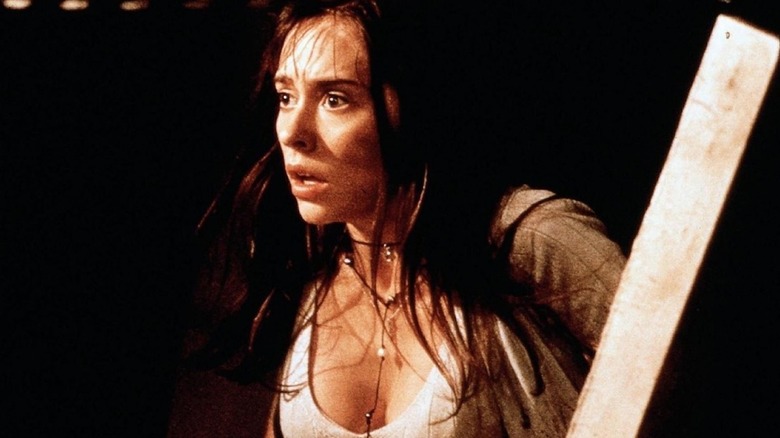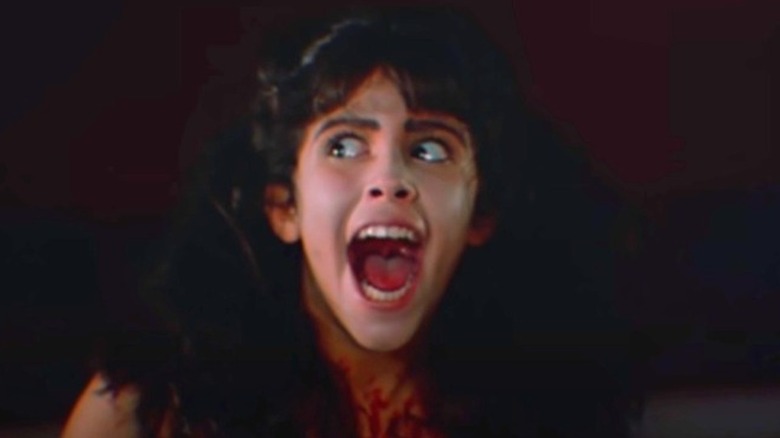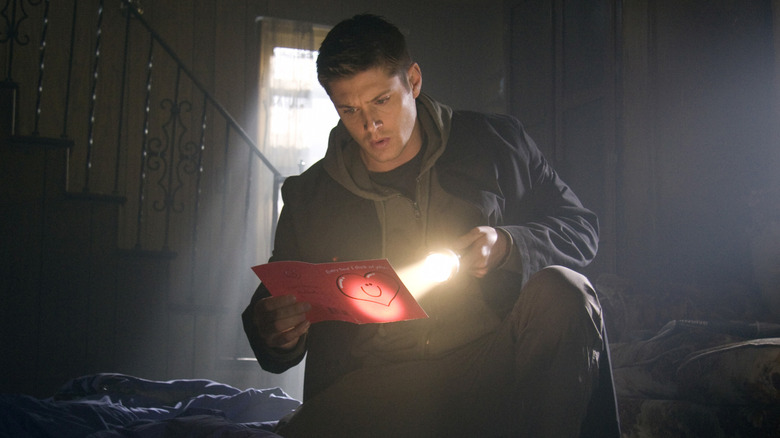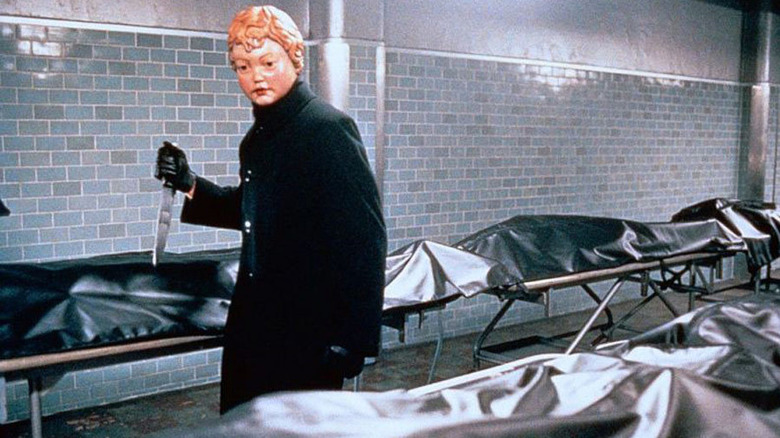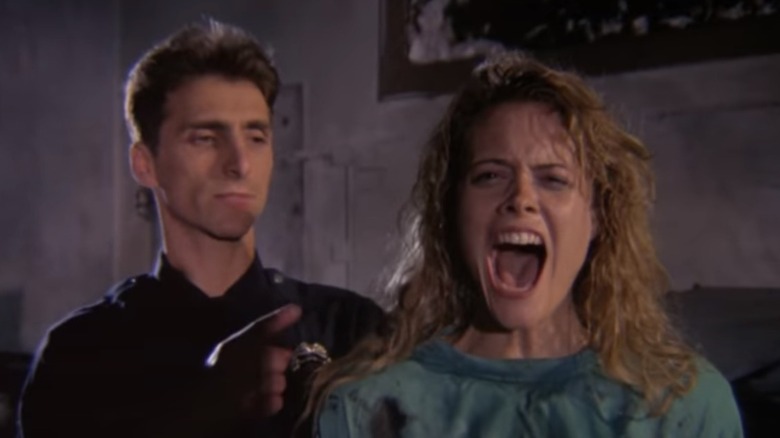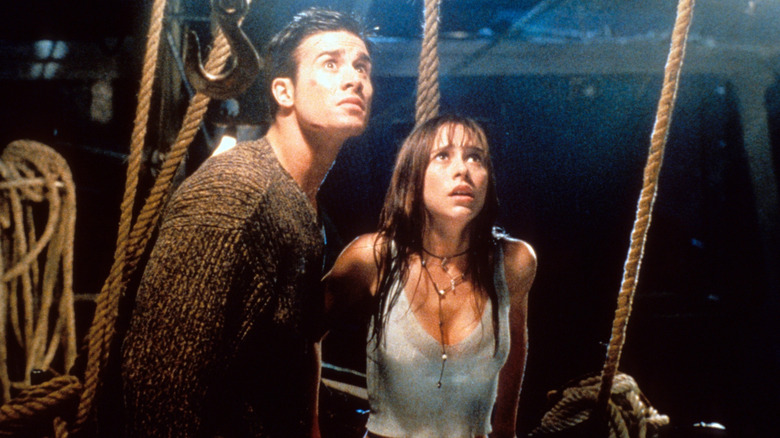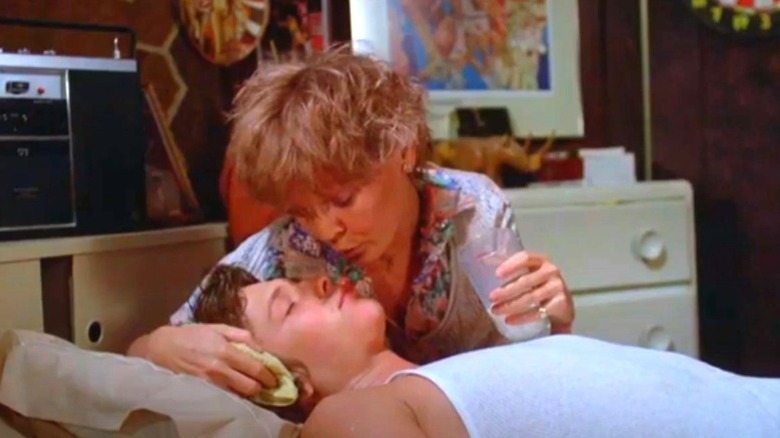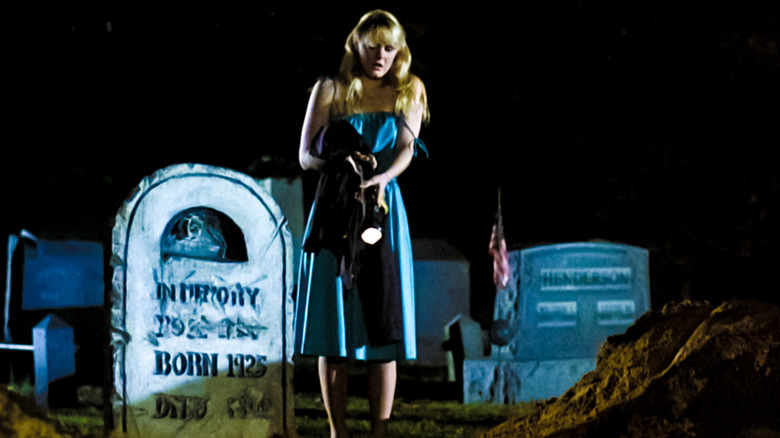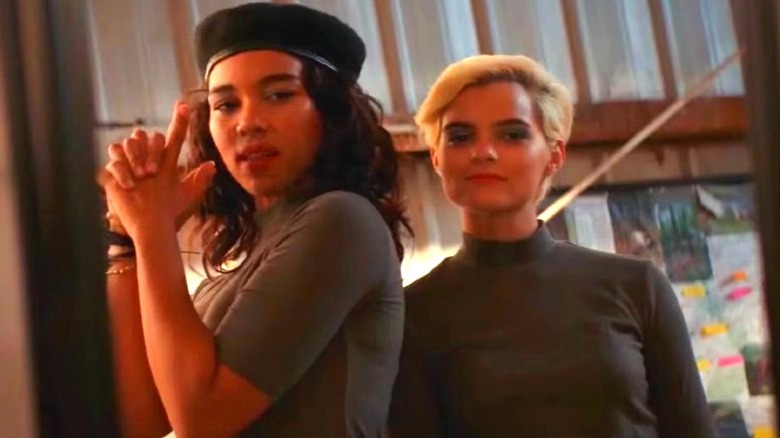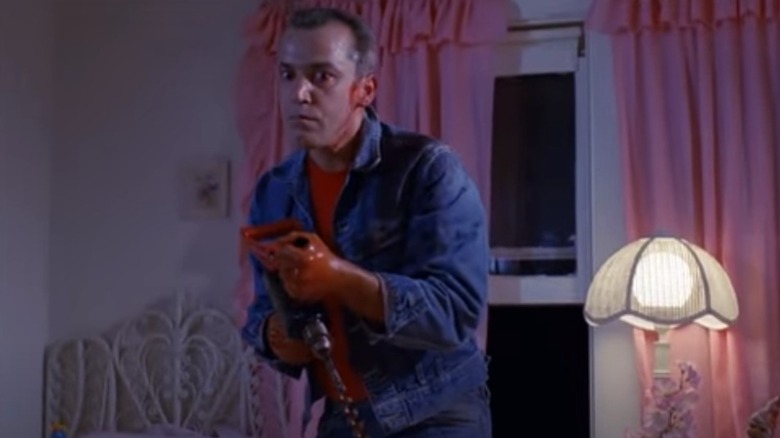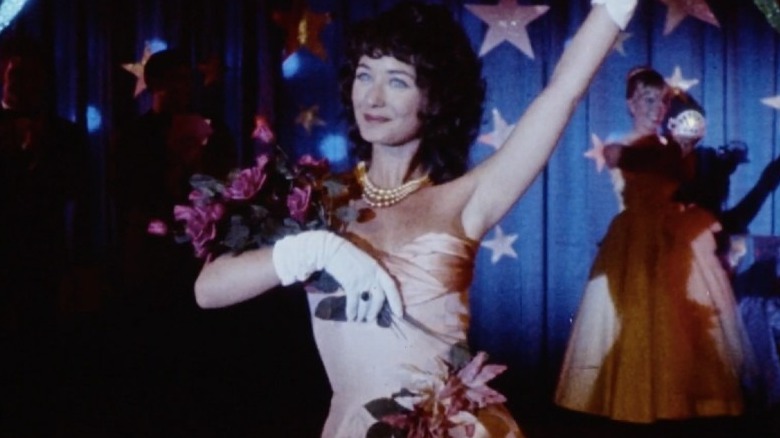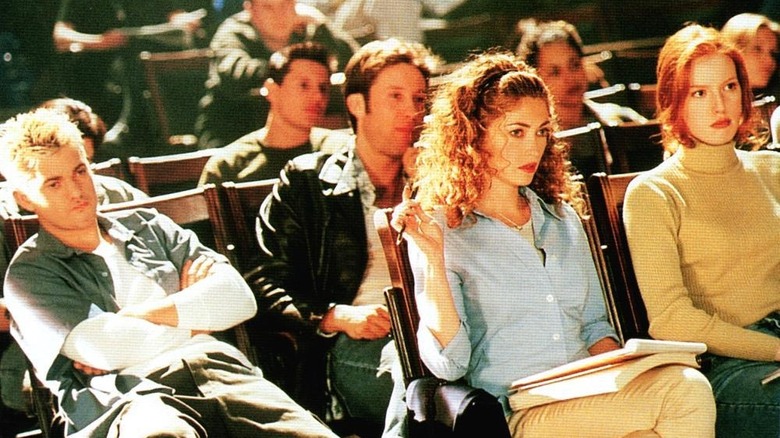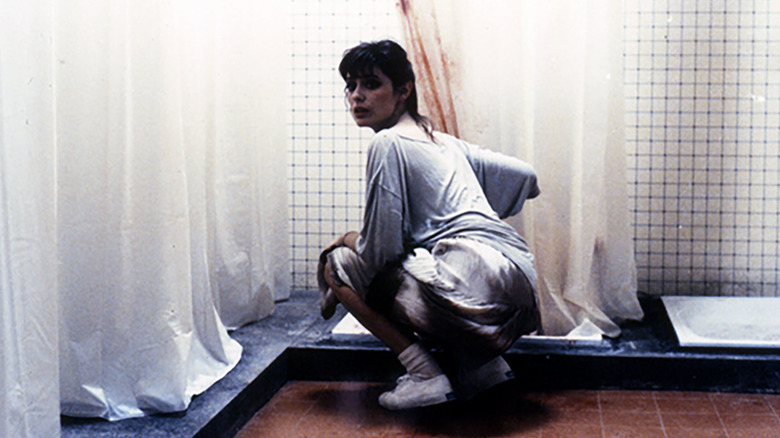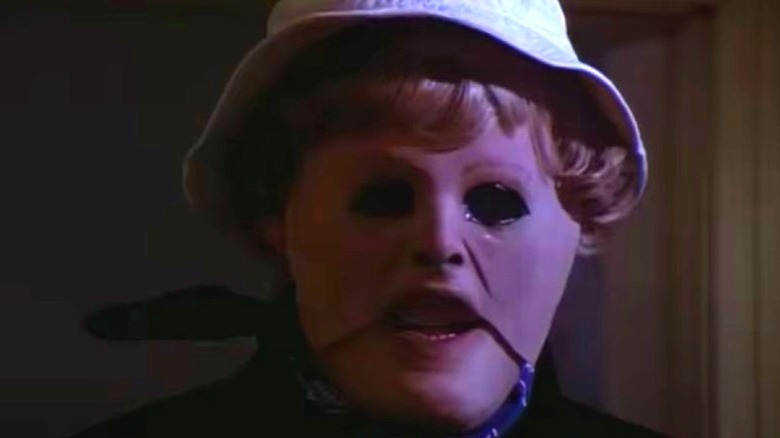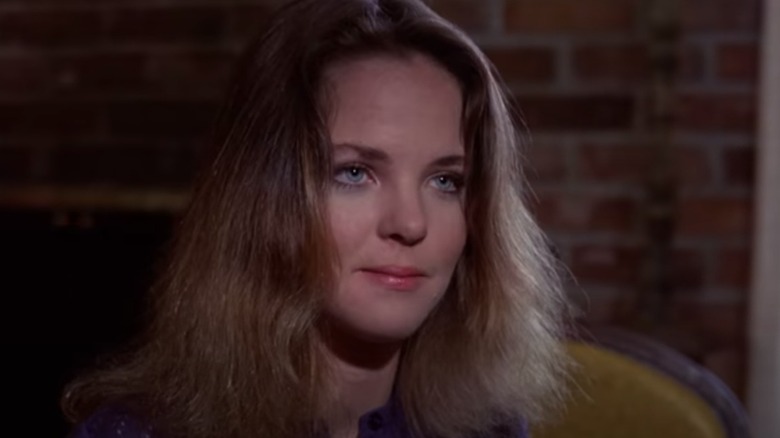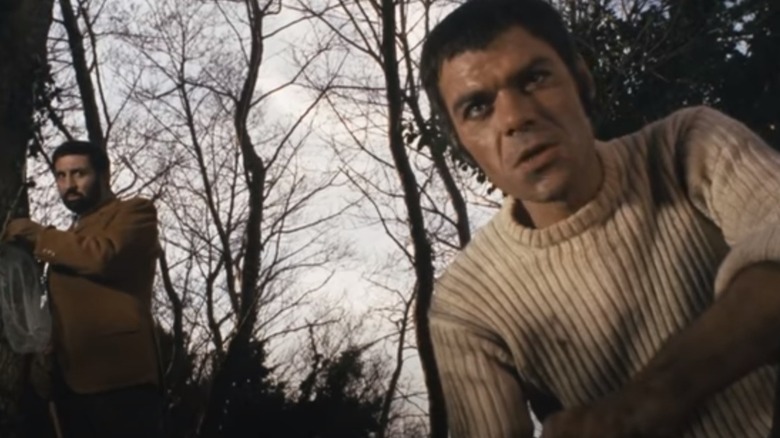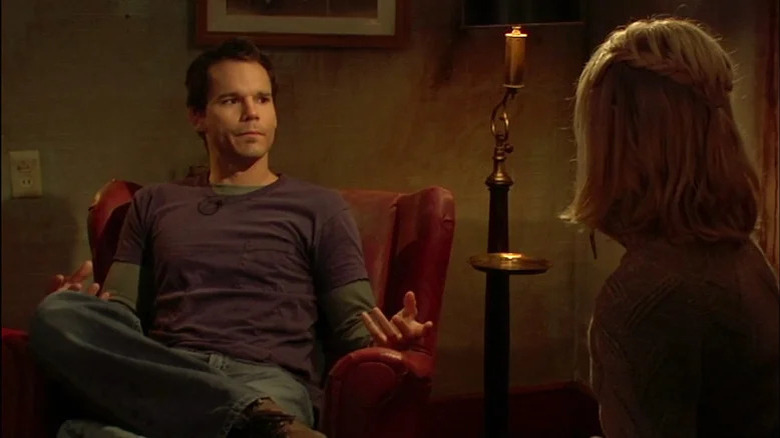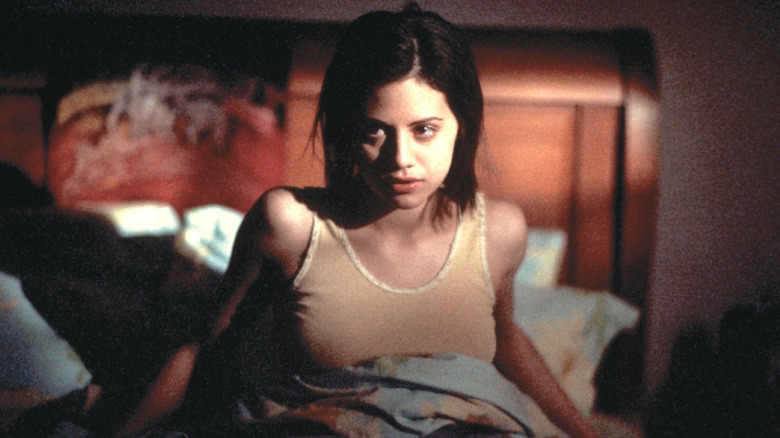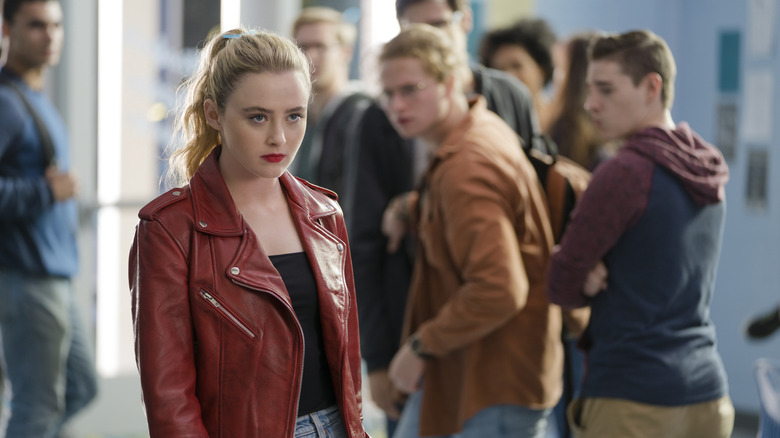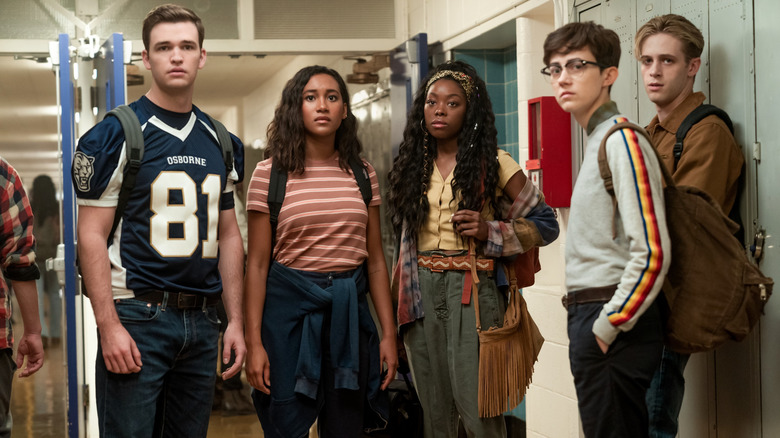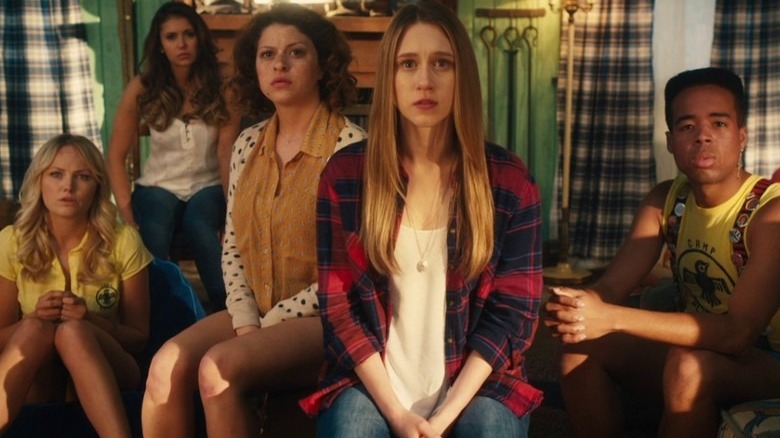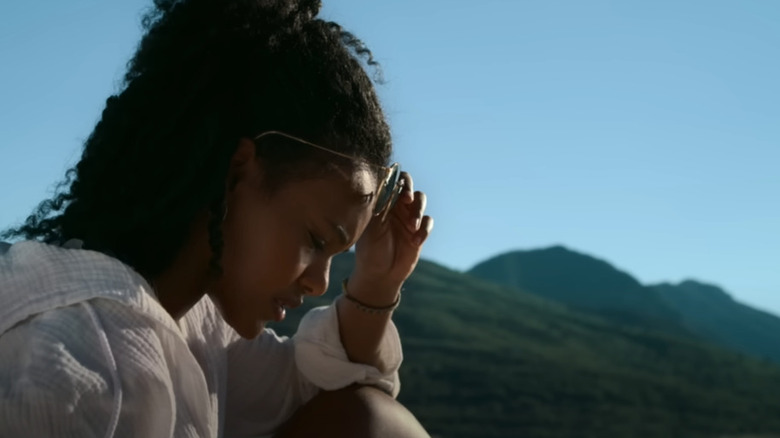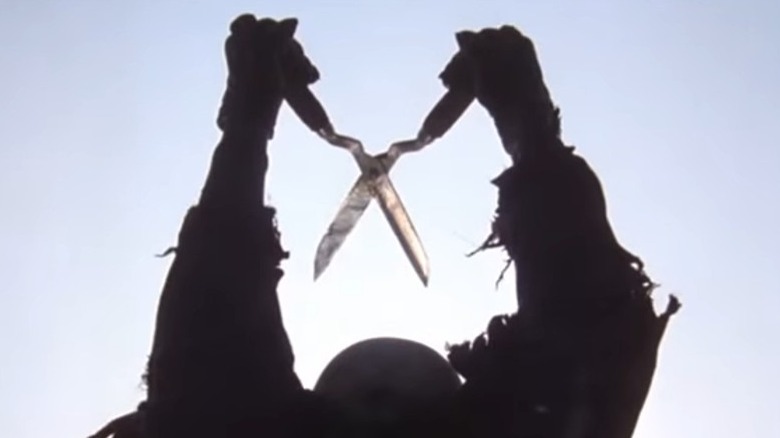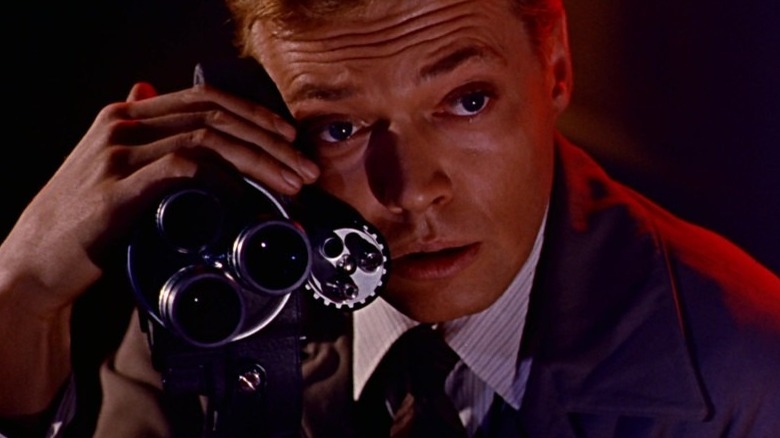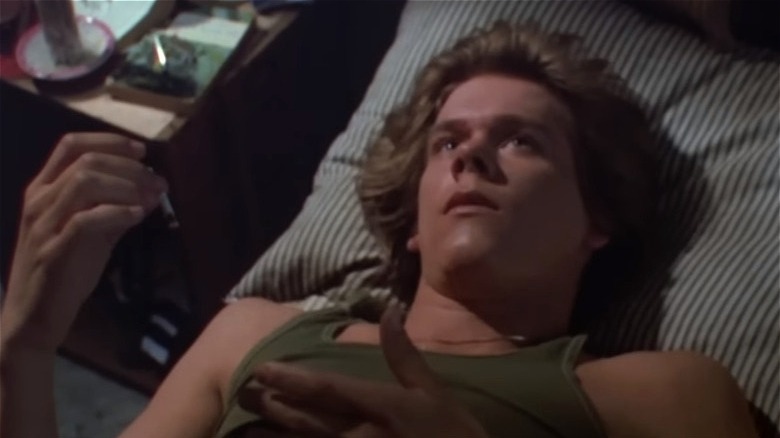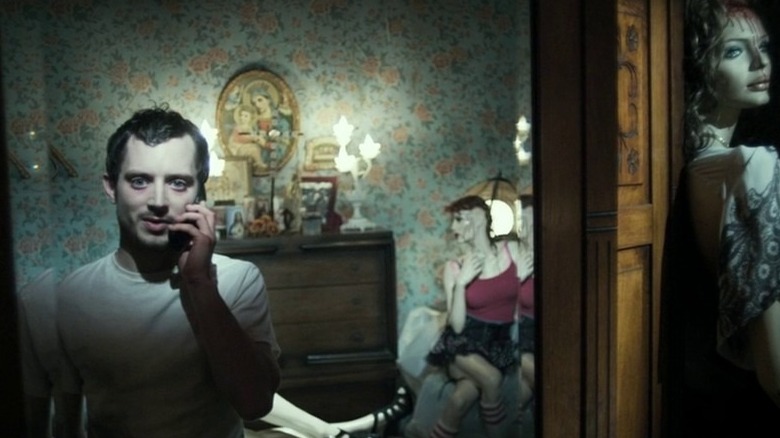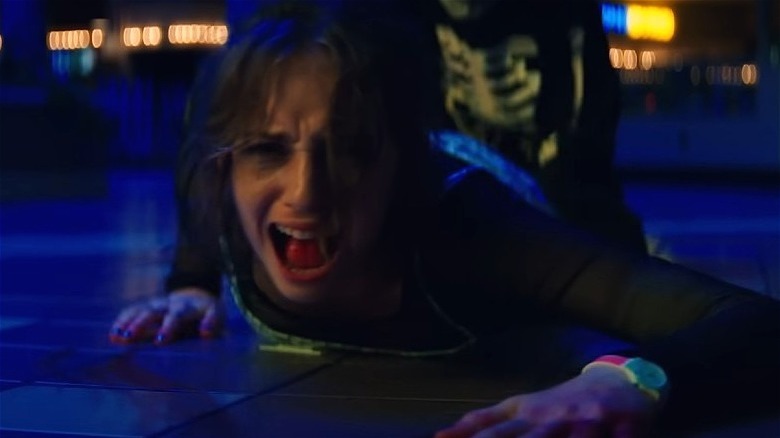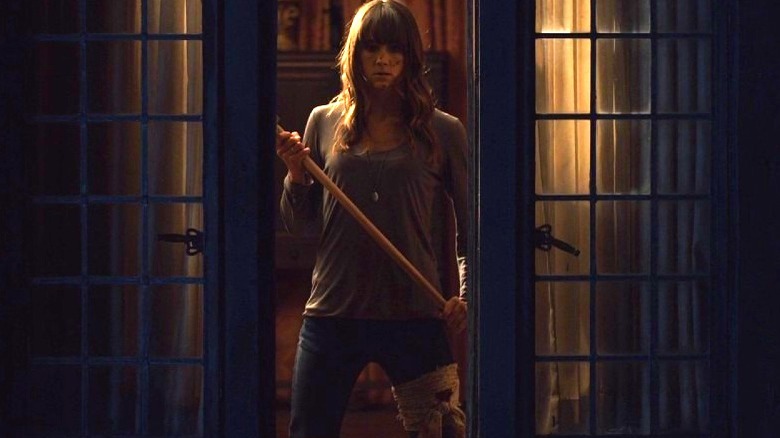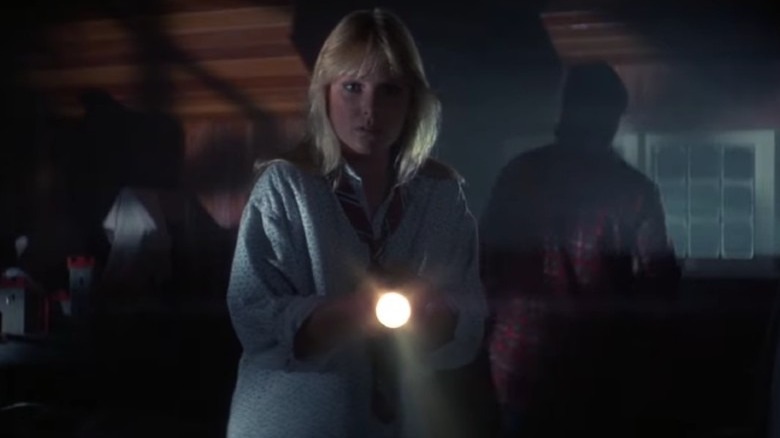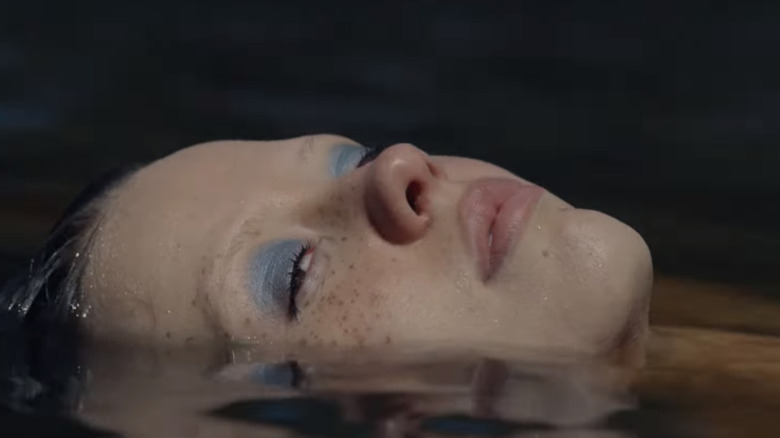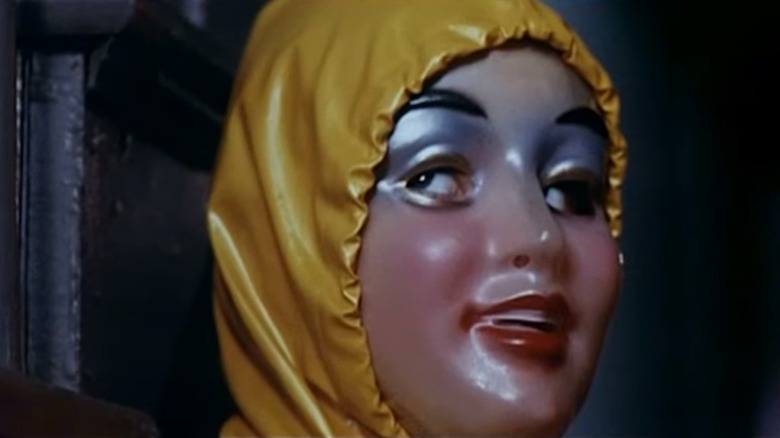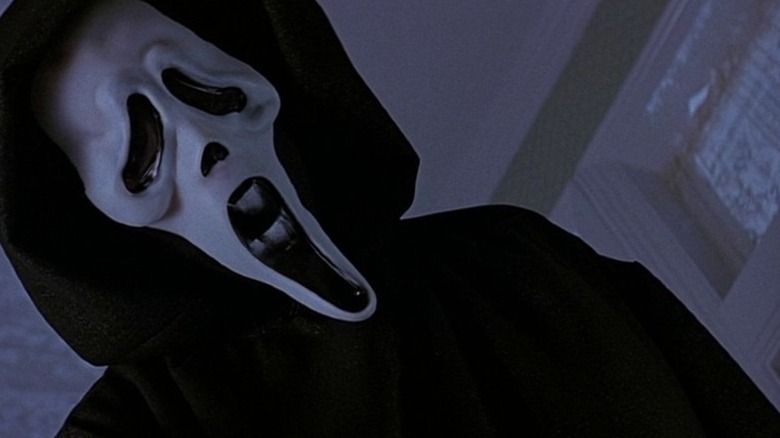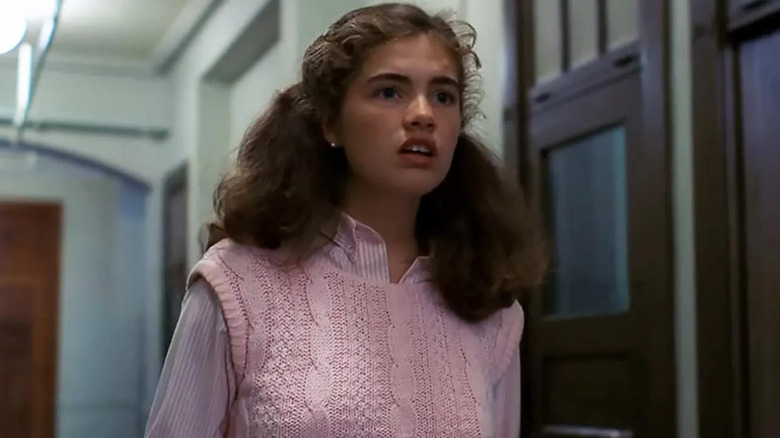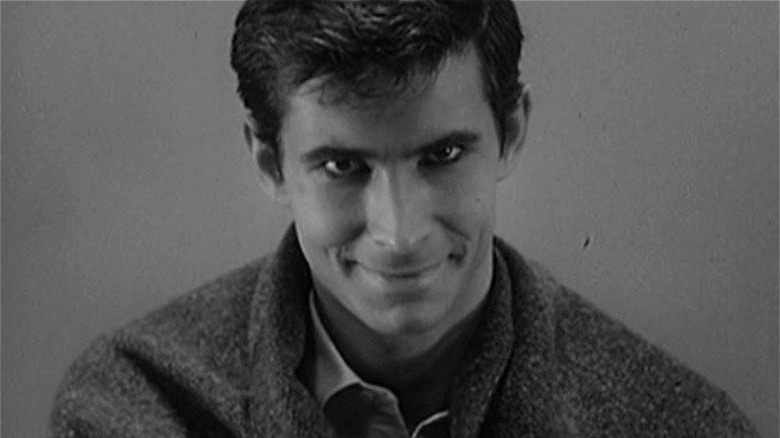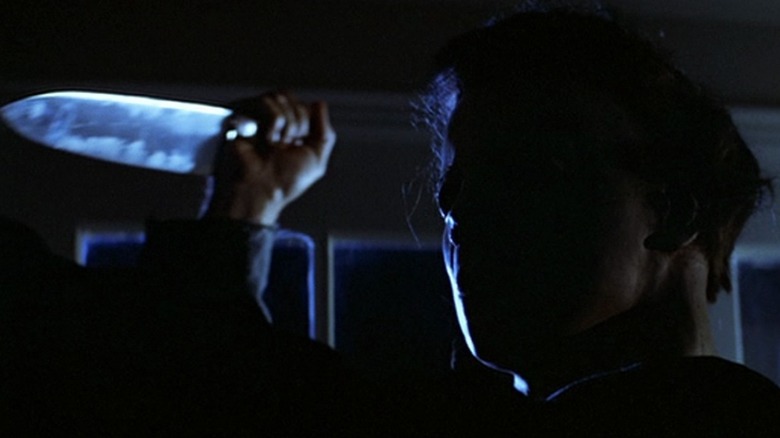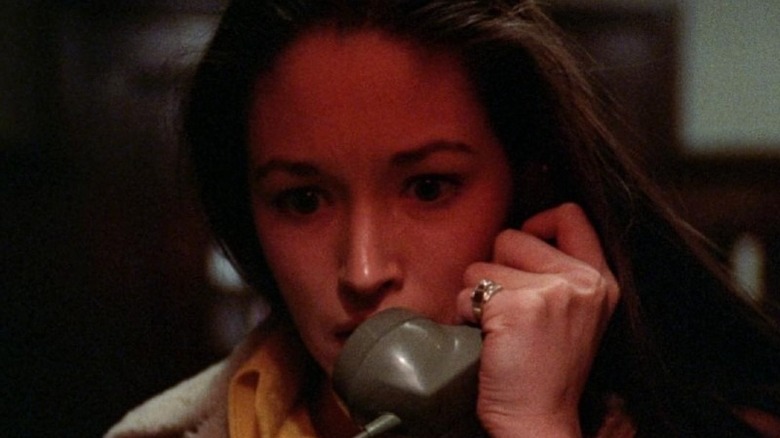The 35 Best Slasher Movies Of All Time Ranked
In 1960, Alfred Hitchcock's "Psycho" brought the fear of monsters into a modern setting. Instead of creatures from the Black Lagoon or caped vampires in castles, the pioneering filmmaker forced audiences to think differently about the dangers lurking in their own backyards. From the butcher knife to the twist ending, it also presented the basic mechanics which would later define the slasher movie subgenre.
Throughout the following two decades, numerous other films, including 1974's "The Texas Chain Saw Massacre," laid the groundwork for the slasher boom of the 1980s. Other early entries, like 1964's "Blood Feast," toyed with grotesque images of severed limbs and tense stalking sequences. Yet, it wasn't until John Carpenter's 1978 classic "Halloween" that the formula was perfected with the incorporation of several other genre tropes such as the Final Girl and the masked killer.
Virtually a direct copy of Carpenter's film"Friday the 13th," arrived two years later, and all bets were off. All the big players, including Wes Craven's "A Nightmare on Elm Street," bought into the subgenre's conventions and pumped out countless sequels. There was "Child's Play" and "Candyman" and "Leprechaun," oh my! By the mid-90s, horror was due for a good ole fashion shakeup, and thanks to 1996's "Scream," slashers were cool again.
For the sake of this greatest list, I opted not to include the usual suspects. Instead, you'll find those slashers that either don't get enough credit for molding the genre or have been sorely underseen. Check your backseat, and buckle up. It's going to be a bloody good ride!
35. Sleepaway Camp
"Sleepaway Camp" is an odd little movie. The story centers on an unknown killer racking up bodies and blood at a summer camp called Camp Arawak. Released in 1983, this unusual slasher (written and directed by Robert Hiltzik) features an abrasive quality in its writing and performances and a heightened campiness that may not work for everyone. It also has one of the most shocking and controversial twist endings in horror history.
With a cast that includes Felissa Rose as shy teen Angela Baker and Desiree Gould as her eccentric Aunt Martha, the schlocky, low-budget feature explores themes of trauma, bullying, and identity with the subtlety of a two-ton sledgehammer.
"Sleepaway Camp" is a welcome change of pace from the "Friday the 13th" series, which never included any actual kids at camp. So there's an emotional component in seeing real kids in danger that elevates the film. Even without the wild revelation of its killer, the violence, gore, and cinematography are more than enough to hook you into the mayhem.
34. My Bloody Valentine
Released in 1981, "My Bloody Valentine" is set in a location you don't often see in slasher movies: a coal mining town. Directed by George Mihalka, the feature follows a group of residents from the town of Valentine Bluffs as they gear up for their first Valentine's Day dance in 20 years.
Two decades before, five miners died in a tragic accident. Trapped underground, the accident's sole survivor, a miner named Harry Warden, turned to cannibalism. Consequently, Warden completely lost his mind and went on a killing spree, tracking down the two supervisors who failed to check methane levels properly.
In the present, the townspeople believe Harry to be dead. Little do they know, Harry has returned, and his vendetta against the town is far from over. He's only getting started. With a script written by John Beaird, the film doesn't do much in pushing the genre forward, but when you think of classic slashers, you better think of "My Bloody Valentine."
33. Valentine
Following the success of "Urban Legend" (also on this list), director Jamie Banks returned with 2001's "Valentine." With a script co-written by Gretchen J. Berg, Aaron Harberts, Donna Powers, and Wayne Powers, this bloody, nail-biting whodunnit exceeds expectations in its playful adherence to the genre. Taking several cues from the classic slashers of the '80s, Banks turns a jilted lover's revenge tale into something far more sinister.
In the film, a young boy named Jeremy (Joel Palmer) is sent to reform school for allegedly assaulting his classmate Dorothy (Kate Logie) — who actually lied about their make-out session Soon after, school bully Joe Tulga (Sterling McCay) severely beat him. Supposedly, Jeremy was then sent to a mental asylum. Years later, around Valentine's Day, someone from Dorothy's dark past returns to seek vengeance on her and her friends. "Valentine" is a smartly written film that is, more than anything, a heartfelt love letter to classic slashers.
32. Intruder
Set in a grocery store, 1989's "Intruder" is an under-appreciated slasher with epic, inventive kills and a high-voltage third act. Directed by Scott Spiegel (who co-wrote the script with "Pulp Fiction's" Lawrence Bender) this little-known flick follows a group of supermarket employees as they're stalked and ground into meat.
After closing time, they're tasked with restocking the shelves and preparing for the next business day, but a mysterious intruder has other plans. Elizabeth Cox stars as Jennifer whose ex-boyfriend Craig (David Byrnes) serves as the obligatory red herring (or is he?) when he shows up and picks a fight with store co-owner Bill (Danny Hicks).
After a few scuffles, Craig is tossed out on the street. The real killer, however, has already slipped into the store and lurks through the aisles and the storerooms. Soon, the employees meet grisly ends. The killer proves he has a flair for the dramatic, posing the bodies of his victims in interesting ways. "Intruder," (which also co-stars the one-and-only Sam Raimi, director of "Evil Dead") is just plain fun.
31. I Know What You Did Last Summer
"I Know What You Did Last Summer" plays by "Scream"s rules, but the 1997 teen horror still has a few tricks of its own up its sleeve. Starring Jennifer Love Hewitt, Sarah Michelle Gellar, Ryan Phillippe, and Freddie Prinze Jr., the film (directed by Jim Gillespie and written by Kevin Williamson) feels meta in some ways yet adheres closely to typical '80s slashers.
After a group of teens party too hard, they end up in a hit-and-run, resulting in the death of an unknown man. Terrified of going to jail, they vow never to tell anyone and dispose of the body by throwing it over a nearby cliff. A year later, Julie (Hewitt), one of the teens, returns home from college to discover that someone knows their dirty, little secret. Soon, a killer's on a rampage to expose the truth. From Julie's street moment ("What are you waiting for, huh?" is forever iconic) to the intense chase involving Gellar, this late '90s slasher is practically perfect in every way.
30. Butcher, Baker, Nightmare Maker
"Butcher, Baker, Nightmare Maker" (also called "Night Warning") is not for the faint of heart, especially if you're part of the LGBTQ+ community. Released in 1981, the film captures the rampant homophobia of the time and how reactionary the general public was to the early outbreak of the AIDS epidemic.
Michael Miller was originally hired to direct and actually filmed the opening sequence before being fired. From there, William Asher signed on and completed the shoot. With a script co-written by Stephen Breimer, Boon Collins, and Alan Jay Glueckman, the story follows high school senior Billy Lynch (Jimmy McNichol) and his cruelly manipulative mother Cheryl, portrayed by Susan Tyrrell, who gives an incredibly deranged performance. As Billy experiments sexually with another student, Julia (Julia Duffy), and plans for his future, his mother doesn't take too kindly to his need to break away.
Bodies hit the floor, but that's not the most terrifying aspect. From a homophobic policeman and frequent use of the "f slur," the film doesn't hold back in portraying the horror many queer people endure. It's a tough watch but an essential one.
29. The Prowler
A dreamy haze permeates much of "The Prowler." Watching the film is almost like witnessing someone's nightmare. Directed by Joseph Zito, who also helmed "Friday the 13th: The Final Chapter," the film contains several brutal kills (realized by special effects makeup genius Tom Savini), including a shower death sequence involving a pitchfork.
While the film (written by Neal Barbera and Glenn Leopold) has a similar tone and story to "My Bloody Valentine," it is far more relentless in its depiction of violence and gore.
In 1945, a young man dressed in army fatigues kills his ex-girlfriend Over three decades later, he makes a ghoulish return and goes on an anniversary rampage, slicing and dicing numerous teens around their graduation. As with most horror movies, the police prove to be, at best, inefficient, claiming a known prowler in the area has been detained. Their negligence leads to needless deaths, but I suppose there wouldn't be a movie otherwise.
28. Tragedy Girls
"Scream 4" crawled so "Tragedy Girls" could run. Addressing similar themes of social media and fame obsession, the 2017 film (directed by Tyler MacIntyre, who co-wrote the script with Chris Lee Hill from an original screenplay by Justin Olsen) combines retro style, modern music, and a savvy genre sensibility.
McKayla (Alexandra Shipp) and Sadie (Brianna Hildebrand) have big ambitions. They want to become the next great serial killers. But there's a problem: They can't get the public or the media to believe a series of troubling deaths to be anything but accidental. To take their careers to the next level, they kidnap a known sociopath and try coercing him into teaching them his ghastly tricks. Dead bodies mount, and differing opinions in their murderous approach lead to a rift between McKayla and Sadie. They eventually iron out their differences and, in the tradition of "Thelma & Louise," hit the open road on a cross-country killing spree. "Tragedy Girls" is a glossy, gory, and glorious thrill ride.
27. The Slumber Party Massacre
One of only a few slashers directed by a woman, 1982's "The Slumber Party Massacre" embraces such cinematic staples of the male gaze as gratuitous nudity and violence against women and repurposes them into a vehicle for agency. With a script written by Rita Mae Brown, director Amy Holden Jones fixates on the hyper-sexuality found in most '80s slashers — down to the killer's long power drill.
As the title suggests, a group of high school girls decides to throw a slumber party. They order pizza, gossip about boys, and chat on the phone. Across the street, new girl Valerie (Robin Stille) babysits her younger sister Courtney (Jennifer Meyers). As bodies drop at their neighbor's place, they are none the wiser. All roads eventually lead to a frantic climax, and Valerie and Courtney soon come face to face with the bloodthirsty maniac. If we're talking movies that expertly capture the spirit of the heyday of slashers, "The Slumber Party Massacre" is right on the money.
26. Hello Mary Lou: Prom Night II
Sometimes, a sequel is just plain better than the original. That's no shade to Jamie Lee Curtis, the star of 1980's "Prom Night." That movie is fine, but it's nowhere near as good as the 1987 follow-up "Hello Mary Lou: Prom Night II."
Directed by Bruce Pittman and starring Lisa Schrage as the title character, the film was originally titled "The Haunting of Hamilton High." However, the producers wanted to capitalize on "Prom Night's" success and name recognition, and the film was retitled. Ron Oliver's script takes supernatural elements and fuses them with the slasher template, giving "Hello Mary Lou: Prom Night II" a heightened charm and sense of mystery.
In 1957, 17-year-old prom queen Mary Lou Maloney is burned to death on stage in a prank gone wrong, Three decades later, she returns from the grave for revenge. Minor similarities to Brian De Palma's "Carrie" aside, "Hello Mary Lou: Prom Night II" more than stands on its own as an essential "slashic."
25. Urban Legend
The late '90s are known for a resurgence in teen horror. Thanks to the success of "Scream," we saw films like "The Faculty," "The Craft," and the Jamie Banks-directed "Urban Legend."
In the film, students at Pendleton University are terrorized by an unknown killer with a fondness for theatrics. As the bodies pile up, the plot races to a heart-pounding reveal.
Urban legends have always sparked curiosity and fear in teenagers, especially in small-town America. From "the killer in the backseat" to invoking Bloody Mary in the mirror, these myths, as well as countless others, are incorporated in various ways "In Urban Legend," making for some standout death sequences.
Featuring a script written by Silvio Horta, the film has all the meta-commentary of "Scream" but possesses a less polished feel, infusing it with more realism than you might expect. Naturally, it's still a slasher movie, so logic often goes out the window. Still, "Urban Legend" is a bright spot in the teen horror canon. A star-studded cast includes Jared Leto, Alicia Witt, Tara Reid, and the nightmare man himself, Robert Englund.
24. StageFright
Michael Saovi, famously known as a protégé of Dario Arengto, made his directorial debut with a film straddling the giallo and slasher genres. In 1987's "StageFright," Soavi utilizes conventions from both genres and melds them into his own ferociously thrilling creation.
The film follows a troupe of actors readying an upcoming production. The pressure is on for the director, Peter (David Brandon), to deliver a worthwhile investment to his producers. When a mental asylum patient escapes from a nearby institution, he trails two actors to the theatre and wreaks havoc. The killer dons an owl costume (the exact one used in the play) and stealthily slips in and out of the shadows.
One particular death scene recreates an actual moment in the show as the rest of the cast, thinking it's all a big goof, looks on from the audience. That's just scraping the surface oh why this film is so effective. Elements of camp, from overly dramatic performances to the killer's generally clumsy nature (think "Prom Night"), make it perfect for Friday night viewing.
23. Tourist Trap
Released in 1979, "Tourist Trap," is an oft-ignored masterpiece. Directed by David Schmoeller (who co-wrote the script with J. Larry Carroll) the wacky, plaster funhouse will make you think quite differently about mannequins.
"Tourist Trap" was one of the first horror movies I ever saw as a kid, and my irrational fear of plastic figures all traces back to two particular scenes: The first involves the villain (Chuck Connors), wearing a disturbing mask that's not unlike a puppet's face, applying fresh plaster to a bound victim's (Tina, played by Dawn Jeffory-Nelson) face. He slowly covers her mouth and nose until her heart bursts in her chest! Later, as the masked killer chases down our final girl, Molly (Jocelyn Jones), he holds up a mannequin head in his right hand, and its mouth gapes open, emitting an eerie, haunting moan.
These supernatural elements give this slasher a necessary and very frightening boost. Connors delivers the performance of a lifetime as deranged mannequin maker Mr. Slausen, the affable yet aloof proprietor of a run-down roadside attraction. An underappreciated horror gem, "Tourist Trap is guaranteed to give you a lifetime of nightmares.
22. Happy Birthday to Me
Directed by J. Lee Thompson, 1981's "Happy Birthday to Me" is a glimpse into childhood trauma and its lingering effects throughout adolescence and early adulthood. "Little House on the Prairie's" Melissa Sue Anderson plays Virginia (or Ginny for short), a teen still reeling from the tragic death of her mother. Her father (Glenn Ford) does all he can for her, and although she's still regularly seeing a therapist, Ginny appears to be living a normal life.
Her friends, an elite clique called the Top Ten, get drunk and drag race over a drawbridge, and the car Ginny is in barely makes it. The near-tragedy awakens something dark and unknown in her. Meanwhile, a killer seeks out Ginny's friends and picks them off one by one, leaving her emotionally distraught and alone.
On a budget in the neighborhood of $4 million, "Happy Birthday to Me" excels as both a horrifying tale and a showcase for Anderson, who commands the screen with a nuanced, evocative performance. The film certainly follows the usual slasher patterns, but the last 20 minutes contain some of the most unsettling imagery in all of horror.
21. A Bay of Blood
We wouldn't have "Friday the 13th" and "Sleepaway Camp" (or literally any other camp-themed horror movie) without Mario Bava's 1971 film "A Bay of Blood" (also known as "Twitch of the Death Nerve"). Much of the narrative unfolds in true giallo fashion: An heiress' murder results in a series of grisly deaths at the hands of a black-gloved killer. There's a mystery, (even more) murder, and mayhem.
The middle chunk of the film is of utmost importance in its influence on the slasher genre, as it revolves around a group of 20-somethings who descend upon a secluded lakeside cabin to get it on and participate in general debauchery. The kills are needlessly graphic, including a spear stabbed through two lovers and a machete to the face. These two moments were directly copied a decade later in "Friday the 13th: Part II."
Initially, you're enticed into Bava's hypnotic spider web of a narrative, and you stay for the carnage candy!
20. Behind the Mask: The Rise of Leslie Vernon
"Behind the Mask: The Rise of Leslie Vernon," co-written by David J. Stieve and director Scott Glosserman, was way ahead of its time. Arriving seven years after "The Blair Witch Project," horror fans were still hungry for found footage, and they were given a feast in the form of this 2006 slasher.
A film crew led by journalist Taylor Gentry (Angela Goethals) documents the life of rising serial killer Leslie Vernon (Nathan Baesel) and his approach to becoming as prolific as Jason Voorhees and Freddy Krueger. Leslie exposes genre conventions and tropes through a mockumentary framework. The viewer sees Leslie's every move from stalking his next prey to scoping out the murder house.
Cameos by Robert Englund, Scott Wilson, and Zelda Rubinstein turn this low-budget affair into an absolute genre blast. It's a shame it never struck enough of a chord with the general public to warrant a sequel. Put simply, "Behind the Mask: The Rise of Leslie Vernon" is a bonafide classic.
19. Cherry Falls
"Cherry Falls" was originally scheduled for theatrical release in November 2000, but problems due to U.S. censorship led studios to opt for a TV debut and later syndication on the USA Network. As a result, it's a largely underseen film and wasn't released on DVD and Blu-ray until 2016. Shudder eventually added it to its library in February 2022.
With obvious "Scream" influences, the flick (directed by Geoffrey Wright, written by Ken Selden, and starring Brittany Murphy) has much more to say than most teen horror movies of the time, particularly in its dissection of morality and sexual assault.
In the film, an unknown killer with long hair and chunky boots targets virgins at a local high school, upending the long-held tradition that only virgins survive horror movies. Jody (Murphy) and her friends combat not only their maturing bodies and pressures to be physical but also a knife-wielding maniac hellbent on destroying their innocence. As the action intensifies, a dark secret involving a young woman named Lora Lee Sherman (Tammy Ballance) comes to light.
Decades later, "Cherry Falls" remains as timely and poignant as ever.
18. Freaky
Director Christopher Landon is making quite a name for himself in the genre fusion department. Where his previous films "Happy Death Day" and its sequel reimagined the 1993 Bill Murray classic "Groundhog Day" as a time-stopping horror movie, his 2019 feature "Freaky" took the Disney comedy "Freaky Friday" and rearranged its parts to create a full-throttle, super gay body swap.
With a script co-written by Michael Kennedy, the film follows Millie Kessler (Kathryn Newton) and her ill-timed encounter with a serial killer known as the Blissfield Butcher (Vince Vaughn). When Millie is stabbed with an ancient dagger called La Dola, she switches bodies with her would-be murderer and has 24 hours to reclaim her body before she's stuck inside his hulking figure for good. Fortunately, she has the help of her BFFs Josh (Misha Osherovich) and Nya (Celeste O'Connor) to undo the spell.
From its meta opening to its general campiness, "Freaky" owes a huge debt to "Scream" but manages to carve out its own unique spot in horror history. It's rare for slasher movies to feature gay main characters, and "Freaky" proves exactly how essential representation is.
17. There's Someone Inside Your House
"There's Someone Inside Your House" doesn't get nearly enough credit. Director Patrick Brice takes what "Scream" did so wonderfully and tosses in social commentary, stirs it up a bit, and presents a profoundly timely story about systemic bigotry and accountability. True to a slasher, there is a masked killer, but this time, they make their own masks to reflect their victims' faces. There's nothing creepier than looking yourself in the eyes while you die. Yikes!
Makani (Sydney Park) harbors a dark secret. She was once involved in a hazing ritual gone terribly wrong, and the guilt she feels almost destroys her. As she contends with her demons, the killer seems to have a vendetta against her and her friends, bringing to light their own vices and past sins. "There's Someone Inside Your House" hinges on the very idea that sometimes the call really is coming from inside your house; no spoilers, but the killer isn't too much of a surprise. Yet it's the buildup that makes this slasher work on every level. It might stand in the shadow of "Scream" and "Halloween," but it makes its presence known enough to land in the Top 20. It deserves that much.
16. The Final Girls
There are few slashers with as much heart as "The Final Girls." Screenwriter Joshua John Miller penned the script with M.A. Fortin and based many of the film's emotional moments on his experiences following the death of his father, actor Jason Miller (who starred as Father Karras in the 1973 classic "The Exorcist").
Directed by Todd Strauss-Schulson, this 2015 slasher riffs on camp-themed horror like "Friday the 13th" to tell a tale about death and grief. On the third anniversary of her mother's death, Max (Taissa Farmiga) attends a late-night screening of the cult horror film "Camp Bloodbath" in which her mother starred. Through a series of "Final Destination"-style twists, she and her friends find themselves transported into the movie. As they are forced to walk through the beats of a typical slasher flick, Max must not only survive until dawn but learn to finally let her mother go.
The film's use of the '80s hit "Bette Davis Eyes" is guaranteed to bring you to tears.
15. Sick
Hear me out on this one. Written by Kevin Williamson ("Scream"), "Sick" is directed by John Hyams ("Alone," "Black Summer") and takes place in the very early days of the COVID-19 pandemic. Right from the start, Williamson brings in things like the toilet paper shortage (gosh, remember that debacle?) to contextualize exactly how it was then. The commentary around empathy for others and the epidemic, in general, is sharp-toothed and relentless. It might be a little on-the-nose, but it works to effectively portray this ongoing era in our lives.
When you get to the heart of it, "Sick" is a fun slasher with plenty of heart-pounding, wig-snatching chase scenes. Like really, it's basically one long chase scene. The masked killer wields the classic butcher's knife, as well as other weapons of destruction. The premise is simple: two friends Parker (Gideon Adlon) and Miri (Bethlehem Million) decide to head out to Parker's family's cabin to quarantine. A love interest for Parker, DJ (Dylan Sprayberry) shows up out of nowhere and confronts Parker about a hook-up she had recently. The trio smoke some pot before dancing in a flurry of bright neons and Lysol disinfectant. Nothing appears out of the ordinary until DJ accidentally allows the killer to slip inside. All bets are off, and, well, it's off to the races from there.
"Sick" is as smartly-written as "Scream" with plenty of carnage to be had. It might not be as mass-appealing as "Scream" but it deserves this Top 15 place.
14. The Burning
A prank goes horribly wrong in Tony Maylam's "The Burning." A bunch of hooligans plants a wormy skull and candles next to the bedside of Camp Blackfoot caretaker Cropsy (Lou David). Cropsy understandably freaks out, then accidentally topples the candles, which set his bedding on fire. He suffers severe third-degree burns over his entire body. You can't help but feel sorry for the poor guy. He was only trying to sleep when the delinquent pranksters upended his entire life. He's not absolved from what comes next, but you do understand it.
A few years later, Cropsy is released from the hospital, even though skin grafts failed to work. Instead, he dons a hat and trench coat to cover his scars. He slowly makes his way to another nearby camp and goes on a murderous rampage, gutting campers left, right, and center. And who could forget that carnage-drenched raft scene 一 it's an absolute slaughterhouse. If "Friday the 13" hadn't been so vital to the slasher genre, "The Burning" may have outpaced it on this list. As such, the waterside heart-pounder is easily a Top 15 finisher for good reason. It's just to die for.
13. Peeping Tom
1960 was a watershed year for the horror genre. Alongside Alfred Hitchcock's "Psycho," "Peeping Tom" yanked cinematic horror into modern times. Not only did it recalibrate genre settings from castles to suburbia, but it also gave the audience a direct line into the murderer's psyche. Most notably, it was one of the first horror films to make use of the killer's point of view (POV). That camera trick would greatly influence many other landmark films, including "Halloween" and "Friday the 13th." However, director Michael Powell's use of first-person perspective feels surprisingly polished and seamless for the time.
Starring Karlheinz Böhm as the socially-inept Mark Lewis (who spends his days working on a film crew), the story follows his twisted obsession with killing "prostitutes," using his camera to capture their dying moments. At the time, the film came under fire for its sexually-charged themes and essentially ended Powell's successful career. A taut script and Böhm's unnerving performance laid the groundwork for countless slashers to follow.
12. Friday the 13th
There are moments in "Friday the 13th" that are so dark you literally can't see a thing. Therein lies the real terror of the Sean Cunningham-directed gorefest. The camera drowns the audience in what it really feels like fumbling around in the dark trying to get away from an unknown assailant. It's a classic whodunnit slathered in graphic, neck-puncturing violence (Kevin Bacon!) and buckets of fake blood. It owes everything to "Halloween," and in fact, Cunningham specifically wanted to cash in on the Michael Myers success and rip it off.
"Friday the 13" is a simple campfire tale about a vengeful mother named Pamela Voorhees (Betsy Palmer) and her plot to make camp counselors pay. When a group of fresh faces decides to reopen Camp Crystal Lake, Pamela doesn't take too kindly to such transgressors, believing them to be exactly like those counselors who let her baby boy Jason drown. She unceremoniously slices and dices and flays them open, leaving bodies all over the camp. She whittles down the group until only Alice (Adrienne King) remains. Little does Pamela know, but Alice is a worthy adversary and eventually beheads Pamela with her own machete.
The film has a rough-around-the-edges quality that makes it an enjoyable watch. It's not the most inspired hack 'n slash, yet it did take what a slasher could be to the next level. It's also not as polished as "Halloween" nor as disturbing as "Black Christmas," but it does hit the sweet spot.
11. Maniac (2012)
Internet discourse would lead you to believe all remakes are bad. That's simply unfounded.
In 2012's "Maniac," a remake of the 1980 cult classic, Elijah Wood plays an unhinged psychopath named Frank with a fixation on mannequins. In the film, Frank has taken over the family business of restoring these relics and selling them to surrounding businesses. However, a troubled childhood has left a deep wound on his psyche, and he turns his trauma into a murderous rampage. He scalps his victims (all women) and staples blood-dripping "wigs" onto his mannequin family. When Frank strikes up a friendship with photographer and artist Anna (Nora Arnezeder), his boundaries and his disturbing sexual urges are put to the test.
Directed by Franck Khalfoun, "Maniac" is true to slasher form but filtered through a "Henry: Portrait of a Serial Killer" lens. Most of the film is shot directly from Frank's perspective, giving the events a raw, exploitative feel. It's far less icky than the original, yet its bizarre finale will make your blood run cold.
10. Fear Street: 1994
"Fear Street: 1994" is an unapologetic love letter to everything great and wonderful about the 1990s. Radiohead, Soundgarden, shopping malls, bookstores, band geek-dom — oh my! Of course, it also pays homage to another '90s staple: "Scream." From the star-studded opening kill (sorry, Maya Hawke, RIP) to the skull mask, it's hard not to think about the 1996 classic when watching the first in the "Fear Street" trilogy from director Leigh Janiak. Its slick, colorful polish is doused in blood and some of the most grisly violence in a modern slasher. That bread slicer kill, anyone? How unfortunate for Kate (Julia Rehwald).
There's a curse that's plagued Shadyside for generations. Every so often, someone in town snaps and kills a bunch of people. Deena (Kiana Madeira) and her brother Josh (Benjamin Flores Jr.) find themselves in the eye of the latest spree and must figure out what role the so-called one-handed witch Sarah Fier (Elizabeth Scopel) plays in all of this. Has her spilled blood soiled the very earth beneath the town's feet or is there more to the story? Things are never as they seem.
While "Fear Street: 1994" rips inspiration directly from "Scream," Janiak carves out something totally unique and just as exciting. I guess you could argue "Fear Street: 1994" is nothing without its companion pieces, "1978" and "1666," as a complete vision of slasher genius, but "1994" more than holds it own as a genre essential.
9. You're Next
In a post-"Scream" world, a slasher's success hinges upon one of two things: It must either be part of a proven franchise (as with the "Halloween" films) or showcase a newcomer with mold-shattering ingenuity. Adam Wingard's "You're Next" (written by Simon Barrett) is a shining example of the latter.
Initially, the film debuted in 2011 at the Toronto International Film Festival (TIFF), but a bungled release delayed its wide theatrical run for nearly two years. Despite standing in the very long shadow of "The Purge," also released in 2013, the film manages to break new ground by marrying slasher tropes to a gritty home invasion storyline. It has a pinch of "The Strangers" blended together with "Funny Games" with a sardonic sense of humor about the millennial generation and the then-current economic recession stitched around its edges.
Starring "Step Up 3D's" Sharni Vinson and featuring an appearance by beloved horror legend Barbara Crampton (best known for "Re-Animator"), "You're Next" is a relentless tour de force that's only gotten better with time.
8. April Fool's Day
"April Fool's Day" arrived relatively late in the slasher craze. A nail-biting whodunnit, the 1986 film follows a group of college students on spring break to their friend Muffy's (Deborah Foreman) secluded island estate. The group is completely cut off from the outside world, and a series of hijinks leads to utter chaos, a string of dead bodies, and the revelation of a deeply troubling backstory. Amy Steel (who established her slasher credentials as "Friday the 13th: Part II's" Ginny) stars as our level-headed and intuitive final girl Kit Graham.
The film, directed by Fred Walton (best remembered for 1979's "When a Stranger Calls" and its 1993 sequel "When a Stranger Calls Back") and written by Danilo Bach, contains all the usual genre delights such as intimate scenes, elaborately gory set pieces, and a shocking reveal. But unlike most of its contemporaries, it flips expectations and blurs even the audience's perception of reality.
7. X
Ti West's "X" is a straight-up love letter to slasher films, largely taking cues from 1974's "The Texas Chainsaw Massacre." It effectively nosedives into '70s sleaze in a way that feels grounded and real. Wayne (Martin Henderson) and his actors want to make an adult film and seek out a secluded homestead far removed from the bright lights of Houston. The location is ripe with potential, and not just for those seeking a good time. Upon arrival, it becomes clear the proprietor Howard (Stephen Ure) and Pearl (Mia Goth) are a little batty. But the group shrugs it off, reasoning that they're old (and maybe senile).
Goth plays double duty and also stars as Maxine, a promising adult film performer dreaming of stardom. Brittany Snow co-stars as Bobby-Lynne, and is joined in the cast by Kid Cudi (as Jackson), Jenna Ortega (as the mousy Lorraine), and Owen Campbell (as RJ, the resident filmmaker and cameraman). The viewer is taken on quite the provocative ride (quite literally) as the group films various graphic intimate scenes around the farm. Even in the barn, if you can believe that.
"X" pays tribute to its predecessors but does something uniquely its own. Known for films like "The House of the Devil" and "The Innkeepers," West has a knack for world-building in such a way that it fully immerses the audience in the proceedings. He rarely disappoints, and "X" is no exception. It earns its rightful place among the big hitters, securing a seventh-place finish.
6. Alice, Sweet Alice
Originally titled "Communion," 1976's "Alice, Sweet Alice" carries all the slasher hallmarks but delivers them with a much sharper blade. The story centers on a deeply troubled young girl named Alice Spages (Paula Sheppard) and her sister Karen (a young Brooke Shields), who is ready to take her first communion at St. Michael's Parish Girls' School. When Karen is gruesomely murdered, a deadly race against time ensues, as a masked killer wearing a bright yellow raincoat seems dead set on making Alice their next victim.
With a screenplay co-written by Rosemary Ritvo and director Alfred Sole (whose other claim to genre fame is the 1982 horror-comedy "Pandemonium"), "Alice, Sweet Alice," engages genre conventions with a perverse irreverence. There's a coarseness in the film's cinematography that grounds the story in gritty realism. Despite its outrageous plot, "Alice, Sweet Alice" is an honest story about lost innocence and trauma.
5. Scream
Wes Craven is a slasher master. Not only did he reinvigorate the genre with "A Nightmare on Elm Street," but he did the same 12 years later with "Scream." He swaps out a razor hand and burned face for a buck hunting knife and a Ghostface mask. While deconstructing genre cliches, he leans into convention as a way to redefine what it means to be a slasher. An iconic killer is introduced, as is a Final Girl that defined an entire generation. Sidney Prescott, played to perfection by Neve Campbell, never came across as hapless or ill-equipped. She was a force to be reckoned with from the very start, more than capable of going toe-to-toe with a pair of imbecilic, hormonal teenagers.
The film follows Sidney as she reels from the death of her mother a year prior. Her wounds are still fresh, but she remains unflinching when it comes time to fight an unknown killer. Ghostface circles around her and her friends and picks them off in grisly scenarios, from a classic stabbing to even a garage door neck-breaker. Ghostface certainly has a flair for theatrics.
"Scream" is as much a trendsetter as it is a love letter. It harkens back to the heyday of slashers while pushing the genre forward into a post-modern, meta arena. Most slashers these days draw influence from "Scream" to some degree. It might not be the top dog on this list, but its Top 5 landing is well-earned.
4. A Nightmare on Elm Street
There are few things as terrifying as a clawed, fedora-wearing sleep demon. Despite the slasher craze quieting down, 1984's "A Nightmare on Elm Street" brought new vitality to the genre. It also introduced one of the best Final Girls in history with Heather Langenkamp's Nancy Thompson. Freddy Krueger, played masterfully by Robert Englund, was once a child killer, and despite the law's best efforts, he was not convicted for his crimes. The parents of his victims take matters into their own hands by tracking him down to an old boiler room and burning him alive. A deserving end to a despicable human being 一 or so everyone thinks.
Years later, Freddy returns and invades the dreams of all the Elm Street children. He targets Nancy and her friends, forcing them to stay awake for days at a time. He's sinister yet playful with the way he toys with his victims. With each killing, Nancy grows more resilient and determined to put Freddy to bed (literally). She buys a survivalist book and equips herself with devices and tools to "Home Alone" her house, with plans to pull him out of her dreams. The boogeyman doesn't stand a chance against Nancy.
"Elm Street" ranks high because, well, it's "Elm Street." It's tense, skin-burning, and thrilling fare that made slashers exciting again. Its mere existence 一 thank you, Wes Craven! 一 still hangs over the genre to this day.
3. Psycho
No one saw it coming. Alfred Hitchcock's "Psycho" was so terrifying that even taking showers sent shivers down the backbone of moviegoers who sat through it. In the years preceding the release of "Psycho," horror films largely depicted monsters, slimy ghouls, and space creatures from another planet. Nothing had been made quite like "Psycho." The idea that horror could take place in a roadside motel, a place you'd never suspect (at least at the time!), laid the foundation for decades of slashers to follow.
"Psycho" tells the tale of Norman Bates (Anthony Perkins) and his mother, who run a motel right off the highway. Nothing appears out of place. In fact, Norman is a normal, if slightly awkward young man trying to do right by his mother and keep the family business afloat. When Janet Leigh's Marion Crane stops by to rent a room, Norman becomes triggered by her appearance and kills her in the shower. Marion's unfortunate death sparks a murder spree. Eventually, Norman is apprehended for his crimes, leading into that bone-chilling final shot that reveals Norman has a split personality and talks to his mother inside his head. Talk about a twist!
To this day, it's hard to surpass the brilliance of "Psycho." However, two slashers do manage to skirt past it on this ranking. Both owing a huge debt to its predecessor, "Halloween" and "Black Christmas" are the cream of the crop. Sorry, Norman.
2. Halloween
What is possibly left to analyze about John Carpenter's "Halloween"? Films like "Black Christmas" and "Alice Sweet Alice" pre-date the Carpenter classic, yet it was "Halloween" that made slashers cool for mainstream audiences. It struck fear into American suburbia; the very notion that the boogeyman could be lurking in your backyard is horrifying. Filmed over 20 days, the slasher is expertly crafted, with mood-dripping shots backdropped on a normal street. Trick or treaters scamper into frame, and the night pushes in on the viewer. It's the way Carpenter approaches the sense of dread and palpable terror that is most masterful. Nothing particularly frightening may happen on screen, but Carpenter makes you believe there is.
"Halloween" tells the simple story of an escaped mental patient who travels back to his hometown and kills babysitters. Laurie Strode (Jamie Lee Curtis) and her friends talk about boys, books, and babysitting. Co-writer Debra Hill is credited for her contributions to their dialogue, presenting them as your typical high school teens. When Michael Myers (Nick Castle) comes to town, they don't know what hit 'em until it's too late. Carpenter's tale absolutely terrified audiences (see for yourself), so it's no surprise a juggernaut film (and franchise) was born out of a meager $325,000 budget. It went on to snag $47 million at the box office and became the highest-grossing independent feature at the time. Still, while "Halloween" is certainly vital to the slasher genre, I won't apologize for arguing that "Black Christmas" did everything better.
1. Black Christmas
John Carpenter's "Halloween" gets all the credit for its mood-setting atmosphere, spine-tingling score, and mouth-breathing maniac. However, "Black Christmas" had all of that and more four years before the Shape stalked Laurie Strode.
Released in 1974, this Canadian proto-slasher took "the babysitter and the killer upstairs" urban legend and turned it into a gobsmacking night of terror. As the winter semester winds down, the sorority girls of Pi Kappa Sigma are saying their goodbyes and imbibing in some festive cheer. Unbeknownst to them, a serial killer, known only as Billy, has climbed into their attic and is making vulgar prank phone calls. Soon, Billy is picking off the girls one by one.
Directed by Bob Clark, best known for the 1983 holiday classic "A Christmas Story," this slow-burning feature more than lives up to its poster's tagline: "If this picture doesn't make your skin crawl... it's on too tight." A stellar cast boasting such names as Olivia Hussey, John Saxon, and Margot Kidder, guarantees a bone-chilling good time.
